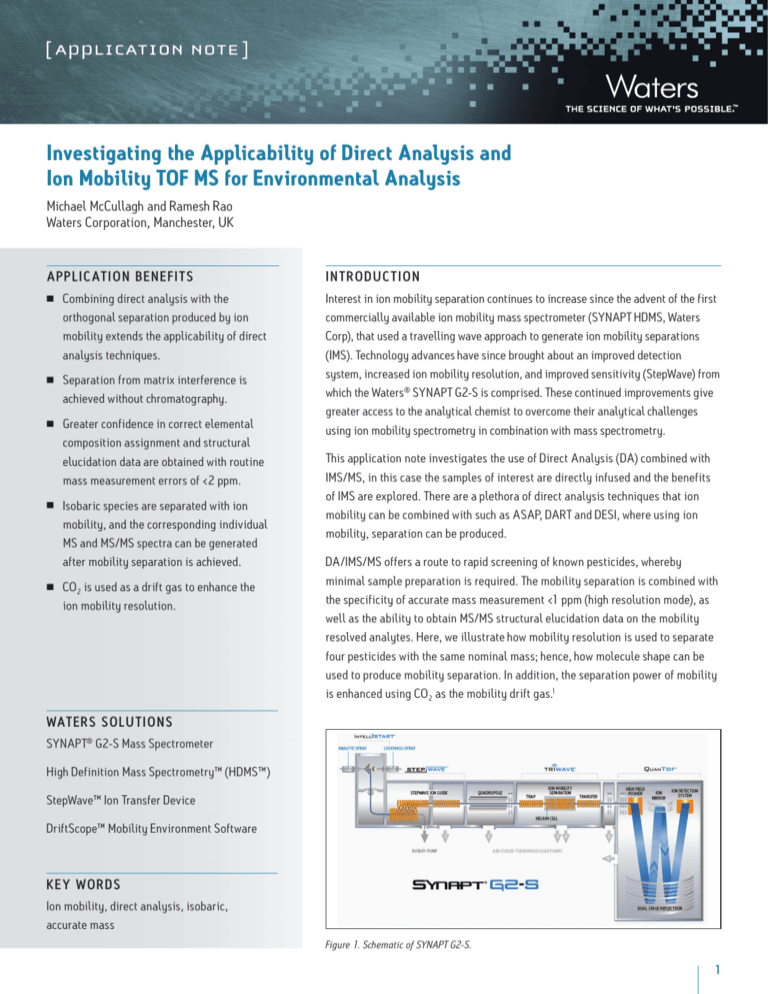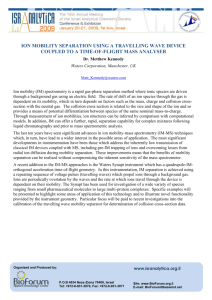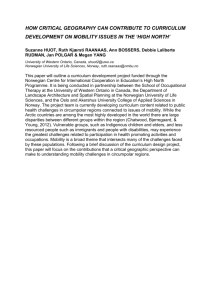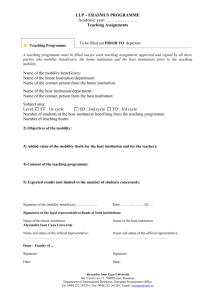Investigating the Applicability of Direct Analysis and Ion
advertisement

Investigating the Applicability of Direct Analysis and Ion Mobility TOF MS for Environmental Analysis Michael McCullagh and Ramesh Rao Waters Corporation, Manchester, UK A P P L I C AT I O N B E N E F I T S ■■ Combining direct analysis with the orthogonal separation produced by ion mobility extends the applicability of direct analysis techniques. ■■ Separation from matrix interference is achieved without chromatography. ■■ Greater confidence in correct elemental composition assignment and structural elucidation data are obtained with routine mass measurement errors of <2 ppm. ■■ ■■ Isobaric species are separated with ion mobility, and the corresponding individual MS and MS/MS spectra can be generated after mobility separation is achieved. CO2 is used as a drift gas to enhance the ion mobility resolution. INT RODUC T ION Interest in ion mobility separation continues to increase since the advent of the first commercially available ion mobility mass spectrometer (SYNAPT HDMS, Waters Corp), that used a travelling wave approach to generate ion mobility separations (IMS). Technology advances have since brought about an improved detection system, increased ion mobility resolution, and improved sensitivity (StepWave) from which the Waters ® SYNAPT G2-S is comprised. These continued improvements give greater access to the analytical chemist to overcome their analytical challenges using ion mobility spectrometry in combination with mass spectrometry. This application note investigates the use of Direct Analysis (DA) combined with IMS/MS, in this case the samples of interest are directly infused and the benefits of IMS are explored. There are a plethora of direct analysis techniques that ion mobility can be combined with such as ASAP, DART and DESI, where using ion mobility, separation can be produced. DA/IMS/MS offers a route to rapid screening of known pesticides, whereby minimal sample preparation is required. The mobility separation is combined with the specificity of accurate mass measurement <1 ppm (high resolution mode), as well as the ability to obtain MS/MS structural elucidation data on the mobility resolved analytes. Here, we illustrate how mobility resolution is used to separate four pesticides with the same nominal mass; hence, how molecule shape can be used to produce mobility separation. In addition, the separation power of mobility is enhanced using CO2 as the mobility drift gas.1 WAT E R S S O LU T I O N S SYNAPT® G2-S Mass Spectrometer High Definition Mass Spectrometry™ (HDMS™) StepWave™ Ion Transfer Device DriftScope™ Mobility Environment Software KEY WORDS Ion mobility, direct analysis, isobaric, accurate mass Figure 1. Schematic of SYNAPT G2-S. 1 E X P E R IM E N TA L MS Conditions MS system: SYNAPT G2-S Ionization mode: ESI+ Capillary and cone voltage: Varied to give optimum signal Desolvation temp.: 200 °C Reference mass: Leucine enkephalin, [M+H] + = 556.2771 Acquisition range: 50 to 1200 m/z Acquisition rate: 1 spectra/s Figure 2. Structures of pesticides analyzed with direct analysis and IMS. Collision energy ramp: 15 to 25 eV Resolution: 18,000 FWHM (Res Mode) Wave velocity: 550 m/s Pulse height: 40 V Direct Analysis: Infusion 5 μL/min Analytes: Hexaconazole, izasophos, dichlorfenthion, and triazophos R E S U LT S A N D D I S C U S S I O N The structures of pesticides of interest were analyzed using direct analysis combined with IMS/MS and IMS/MS/MS, as shown in Figure 2. They have the same nominal mass and charge state, but different elemental composition and, hence, shape. The pesticides were directly analyzed using infusion. The mobility chromatograms illustrating the drift times for hexaconazole, izasophos, dichlorfenthion, and triazophos using N2 as the drift gas are shown in Figure 3. This data demonstrates that even without chromatography these components can be partially resolved using peak capacity provided by ion mobility, with arrival times varying between 1.84 and 2.11 ms. 314.9778 Dichlorfenthion 314.0495 Isazophos 314.0728 Triazophos 314.0827 Hexaconazole 1 2 3 4 Dt = 1.84 ms Dt = 2.00 ms δ = 0.16 ms Dt = 2.11 ms δ = 0.11 ms Dt = 2.11 ms δ = 0.0 ms Figure 3. Mobility chromatograms illustrating the arrival times for pesticides shown using N2 . Investigating the Applicability of Direct Analysis and Ion Mobility TOF MS for Environmental Analysis 2 W hen performing IMS, the ion separation occurring in the travelling wave ion mobility (T WIM) drift cell is determined by the charge state, mass, shape, drift gas polarizability, as well as interaction between ion and neutral gas molecules. Increasing the polarizability of the drift gas resulted in an increase in the separation power of T WIM, in this application. T his is illustrated in Figure 4, where mobility chromatograms show the drift times for pesticides analyzed using CO2 as the drift gas of choice. T he arrival times varied between 3.24 and 4.05 ms. T he comparison between physical properties of the ion mobility drift gases utilized is shown in Table1. A comparison of the peak resolution obtained using (Rs=1.18(ta-tb)/W0.5,a+W0.5,b) is shown in Table 2. T he resolution between peaks 1 and 2 showed a slight decrease in resolution, but in all other cases peak resolution increased using CO2. T he pesticides were infused as a mixture and the peak detected components, shown in Figure 5, can be seen in DriftScope showing arrival time versus m/z for the pesticides with CO2 as the drift gas. For hexaconazole and triazophos, sodiated adducts were observed and mobility separated. It can be difficult to avoid adduct formation, particularly in the presence of matrix. However, it is possible to provide further identification confidence by using the ion mobility, i.e. a second identification point from the drift time of the adduct formed. 314.9778 Dichlorfenthion Dt = 3.24 ms 1 314.0495 Isazophos Dt = 3.40 ms 2 314.0728 Triazophos δ = 0.16 ms Dt = 3.67 ms 3 314.0827 Hexaconazole δ = 0.27 ms Dt = 4.05 ms δ = 0.38 ms 4 Figure 4. Mobility chromatograms illustrating the arrival times for pesticides shown using CO2 as the drift gas. S ynaptG 2_201101206_061b.r aw : 1 DriftScope Mobility separated Peak detected pesticides N a + Adducts . . H + Adducts Figure 5. Peak detected pesticides in DriftScope showing arrival time versus m/z for the pesticides of interest. CO2 is the drift gas. Investigating the Applicability of Direct Analysis and Ion Mobility TOF MS for Environmental Analysis 3 SynaptG2_201101206_061b_dt_01 78 (4.158) AM2 (Ar,18000.0,556.28,0.00,LS 3) % 100 0 314.0827 Hexaconazole [M+H]+=314.0827 315.0864 318.0775 319.0802320.9832 % 0 314.0733 Triazophos [M+H]+=314.0728 Error=1.6ppm 315.0753 316.0715 305 306 307 308 309 310 311 312 313 314 315 316 317 318 319 320 321 322 323 324 325 326 327 328 329 330 % 0 314.0501 Isazophos [M+H]+=314.0495 Error=1.9ppm 316.9748 318.9720 305 306 307 308 309 310 311 312 313 314 315 316 317 318 319 320 321 322 323 324 325 326 327 328 329 330 % 0 Dichlorfenthion [M+H]+=314.9778 m/z 1: TOF MS ES+ 1.76e5 316.0470 314.9784 SynaptG2_201101206_061b_dt_01 63 (3.348) AM2 (Ar,18000.0,556.28,0.00,LS 3); Cm (62:64) 100 m/z 1: TOF MS ES+ 1.02e5 SynaptG2_201101206_061b_dt_01 66 (3.510) AM2 (Ar,18000.0,556.28,0.00,LS 3); Cm (65:67) 100 322.9789 305 306 307 308 309 310 311 312 313 314 315 316 317 318 319 320 321 322 323 324 325 326 327 328 329 330 SynaptG2_201101206_061b_dt_01 71 (3.780) AM2 (Ar,18000.0,556.28,0.00,LS 3) 100 1: TOF MS ES+ 1.64e5 Error=0.0ppm 316.0802 314.9783 316.9752 314.0488 315.9816 m/z 1: TOF MS ES+ 1.47e5 Error=1.3ppm 318.9721 319.9741 305 306 307 308 309 310 311 312 313 314 315 316 317 318 319 320 321 322 323 324 325 326 327 328 329 330 m/z Figure 6. Single component accurate mass spectra generated from the mobility chromatograms extracted using DriftScope, as shown in Figure 5. The peak capacity generated using ion mobility enables the accurate mass spectra of each single component to be obtained; therefore, completely resolved from any background ions, as shown in Figure 6. The single component accurate mass spectra were generated from the mobility chromatograms extracted using DriftScope. Accurate mass measurements with <2 ppm error were achieved, and elemental compositions proposed based on the potential to be comprised of the C,H,N,O,P,S and Cl. The exact masses of the [M+H] + species are shown in conjunction with the accurate mass spectra generated and mass measurement error obtained. In all cases, each target pesticide was identified correctly as the most probable analyte, based on accurate mass and isotopic pattern within the elemental composition calculator. The schematic of the SYNAPT G2-S, shown in Figure 1, reveals two regions labelled “Trap” and “Transfer” before and after the ion mobility T-Wave. Collision energies can be applied in either of these regions. After mobility separation was achieved, a collision energy ramp was applied in the Transfer region. This enabled the single component MS/MS spectra to be obtained for all pesticides when infused as a mixture. The individual characteristic MS/MS spectra obtained are shown for dichlorfenthion, triazophos, hexaconazole, and isazophos in Figures 7 through 10, respectively. Using quadrupole technology selectivity, typical mass resolution would result in a 1 Da span across the mass selected when performing MS/MS. Without mobility separation, it would not be possible to obtain the single component MS/MS spectra as shown for the pesticides analyzed using direct analysis. Conventional infusion of all four pesticides would result in an MS/MS product ion spectrum comprised of all four analytes. In this case, the resolving power of the quadrupole has been used to select m/z 314 where only this mass undergoes mobility separation, resulting in the mobility separation of the four pesticides shown, followed by fragmentation of each individual species. Excellent mass accuracy was obtained, with mass measurement errors of <3 ppm. The fragments are generated from the mobility resolved species and will, therefore, have the same drift time. In Figures 3 and 4, a unique mass fragment was selected to illustrate the drift times of each of the four pesticides. This approach further confirmed the identification of the pesticides determined to be unresolved when N2 was used as a drift gas utilizing IMS/MS. Investigating the Applicability of Direct Analysis and Ion Mobility TOF MS for Environmental Analysis 4 SynaptG2_201101206_060a_dt_01 60 (3.186) AM2 (Ar,18000.0,556.28,0.00,LS 2) 1: TOF MSMS 0.00ES+ 8.03e4 258.9158 100 % 260.9127 [M+H]+ =314.9778 Error= 0.6ppm Dichlorfenthion 96.9519 162.9716 ! 178.9490 142.9904 0 60 80 100 120 140 160 180 262.9092 286.9466 288.9435 224.9290 240.9051 222.9385 200 220 240 290.9404 314.9780 260 280 300 320 340 SynaptG2_201101206_060a_dt_01 70 (3.726) AM2 (Ar,18000.0,556.28,0.00,LS 3) 360 m/z Figure 7. Single component accurate mass MS/MS spectrum of dichlorfenthion generated after IMS of the infusion of a pesticides mixture, as shown in Figure 2. 1: TOF MSMS 0.00ES+ 9.27e4 162.0669 100 % [M+H]+ =314.0728 Error=1.3ppm Triazophos 314.0732 163.0703 315.0765 286.0425 96.9517 0 50 60 70 80 90 178.0444 190.0984 119.0608 316.0695 258.0109 100 110 120 130 140 150 160 170 180 190 200 210 220 230 240 250 260 270 280 290 300 310 320 330 SynaptG2_201101206_060a_dt_01 76 (4.050) AM2 (Ar,18000.0,556.28,0.00,LS 3); Cm (75:79) m/z Figure 8. Single component accurate mass MS/MS spectrum of triazophos generated after IMS of the infusion of a pesticides mixture, as shown in Figure 2. 1: TOF MSMS 0.00ES+ 2.63e5 314.0829 100 M+H]+ = 314.0827 Error=0.6ppm Hexaconazole 70.0414 % 316.0803 318.0775 158.9772 71.0433 0 60 80 120 140 160 180 200 319.0800 245.0503 188.9876 100 220 240 260 280 300 320 340 360 380 400 m/z Figure 9. Single component accurate mass MS/MS spectrum of hexaconazole generated after IMS of the infusion of a pesticides mixture, as shown in Figure 2. Investigating the Applicability of Direct Analysis and Ion Mobility TOF MS for Environmental Analysis 5 SynaptG2_201101206_060a_dt_01 64 (3.402) AM2 (Ar,18000.0,556.28,0.00,LS - 3); Cm (6460) 162.0439 100 1: TOF MSMS 0.00ES+ 2.27e4 M+H]+ = 314.0495 Error=3.2ppm Isazophos 314.0505 % 119.9965 164.0410 316.0469 272.0034 121.9935 96.9514 243.9717 153.0136 286.0184 124.9825 245.9677 148.0272 0 50 60 70 80 90 165.0427 288.0161 317.0496 215.9386 190.0755 100 110 120 130 140 150 160 170 180 190 200 210 220 230 240 250 260 270 280 290 300 310 320 330 m/z Figure 10. Single component accurate mass MS/MS spectrum of isazophos generated after IMS of the infusion of a pesticides mixture, as shown in Figure 2. Ion Mobility Spectrometry provides an extra dimension of fast, gas phase, ion separation, providing higher ion definition and analytical specificity. Using DA/IMS/MS/MS, four pesticides were profiled using a SYNAPT G2-S. T he results demonstrate that HDMS can provide a route to specific and unambiguous identification, even where no chromatographic separation exists. Future studies will utilize UPLC/IMS/MS for screening pesticides in complex matrices to further illustrate the benefits of the enhanced peak capacity enabled using IMS. Mobility drift gas Mass Polarizability (10e-24 cm3) Nitrogen N2 28.0123 1.7403 Carbon dioxide 44.0098 2.9110 Table 1. Physical properties comparison where ion mobility drift gases were utilized. Drift gas Peak resolution 1+2 2+3 3+4 1+3 1+4 2+4 CO2 0.47 0.82 0.95 1.24 1.99 1.10 N2 0.61 0.37 0 0.89 0.99 0.42 Table 2. A comparison of peak resolution obtained for the direct analysis of four isobaric pesticides using N2 and CO2 drift gases. Investigating the Applicability of Direct Analysis and Ion Mobility TOF MS for Environmental Analysis 6 References C O N C LU S I O N S ■■ Direct analysis infusion mobility separation of pesticides with the same nominal mass were utilized to illustrate the separation that can be achieved with ion mobility. 1. Eberlin MN, Lali PM, Nachtigall FM, Riccio MF, de Sa GF, Daroda RJ, de Souza V, Campuzano I, Souza G HMF. 4 Improving Ion Mobility Separation By Increasing Drift-Gas Polarizability. Waters Technical Note No. 720003201EN, 2009. ■■ Comparative application data where N2 and CO2 drift gases were used to perform T-wave IMS were generated, where CO 2 was shown to improve the mobility separation for this application. 2. Asbury GR, Hill HH. Using Different Drift Gases To Change Separation Factors ® in Ion Mobility Spectrometry. Anal. Chem. 2000; 72: 580. ■■ Single-component MS spectra have been produced from the mobility separation generated for the pesticides studied. ■■ Mass measurement errors of <2 ppm have been illustrated. ■■ Characteristic single-component MS/MS spectra were produced from the mobility separation of the pesticides analyzed. ■■ The study undertaken warrants further investigation of the enhanced peak capacity that UPLC/IMS/MS can enable in pesticide screening applications. ■■ The application illustrates how ion mobility can be used to increase peak capacity with any direct analysis technique. Waters and SYNAPT are registered trademarks of Waters Corporation. StepWave, DriftScope, T-Wave, High Definition Mass Spectrometry, HDMS, and T he Science of W hat’s Possible are trademarks of Waters Corporation. All other trademarks are the property of their respective owners. ©2012 Waters Corporation. Produced in the U.S.A. October 2012 720004465EN AG-PDF Waters Corporation 34 Maple Street Milford, MA 01757 U.S.A. T: 1 508 478 2000 F: 1 508 872 1990 www.waters.com






![CHEER Seminar Promo: 2nov2015 [DOC 142.50KB]](http://s3.studylib.net/store/data/007520556_1-22ae8f83ff74a912c459b95ac2c7015c-300x300.png)

